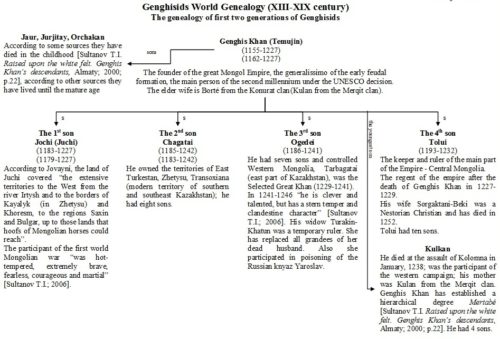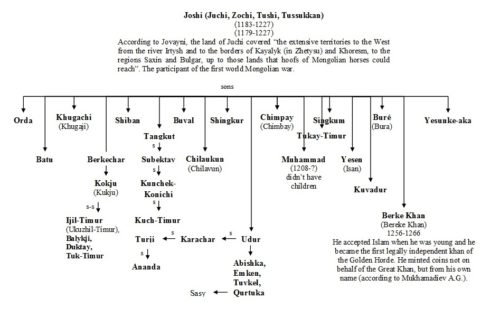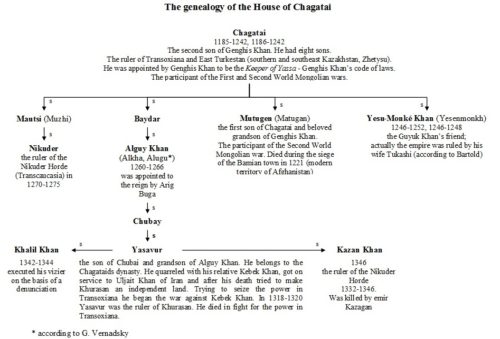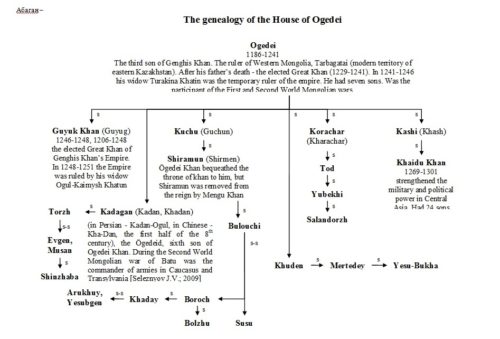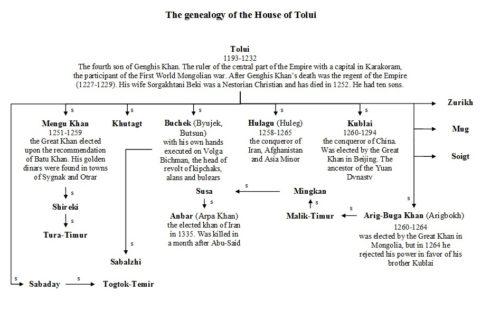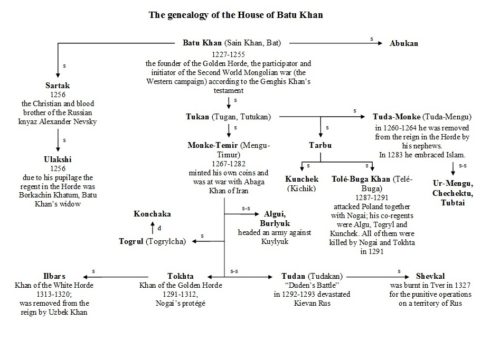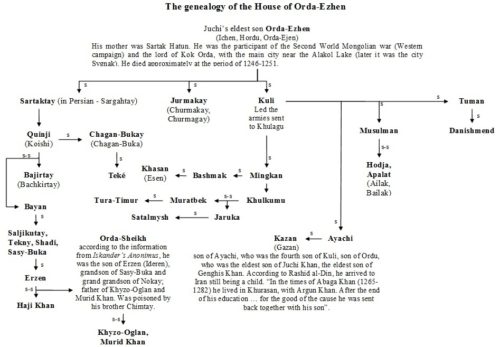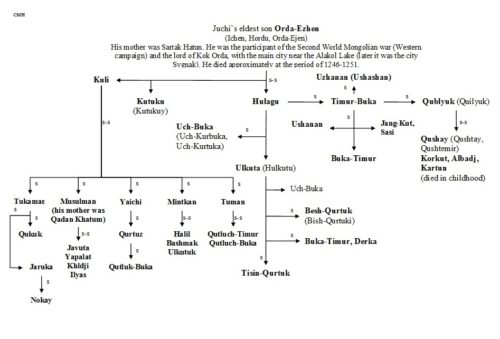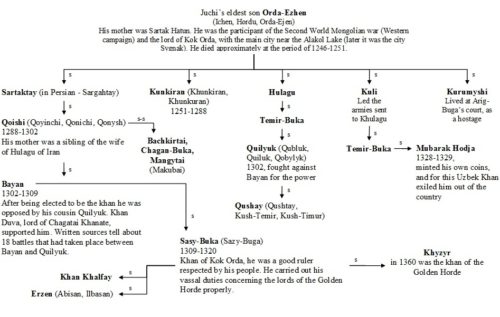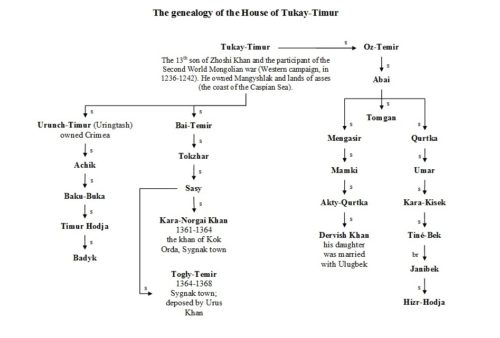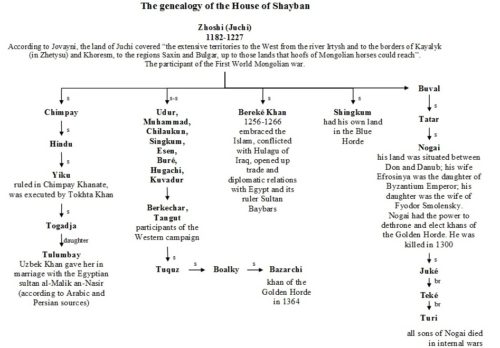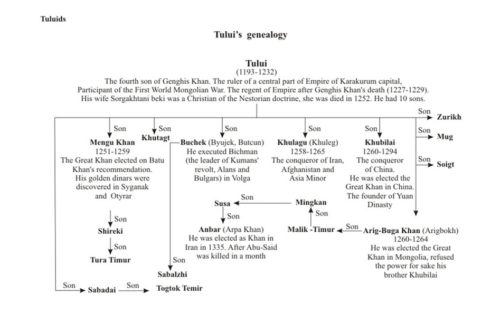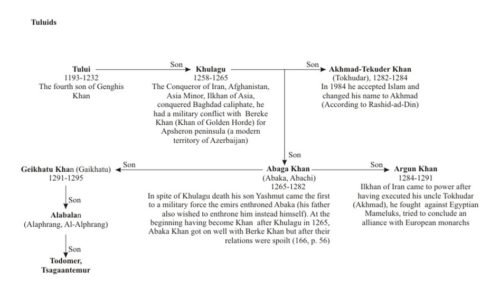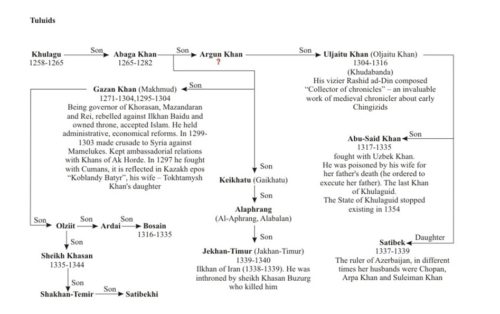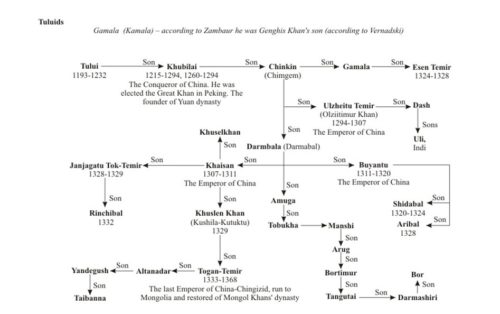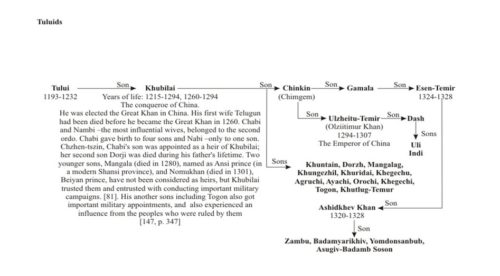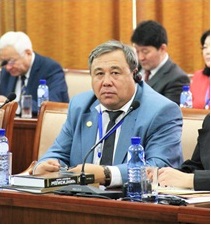
«That is what was known from chronicles,
also what was heard and learnt, – all these are mentioned in this
genealogic. And everyone who will learn something about
theirdescendants,should write down it»
From «Tavarihi – I guzida –ii Nusrat-name» chronicle
The formation of historical and social-political landscape of Eurasian continent connected with a principle of the succession of ruling Chingizids’ dynasty originated from Genghis Khan. This genealogy was appeared in the medieval period in Asia. The depth of research is about 800 years.
On December 1995 Washington newspaper acclaimed Genghis Khan as a person of the second millennium. In the capital of USA – Washington is planning to erect a bronze monument devoted to Genghis Khan. On the eve of 800 years anniversary of Mongolian Empire’s formation the president of USA – J. Bush made an official visit to Ulan-Bator, he talked with young Mongolian researchers and historians about 3 hours. Following the results of visit, they were suggested to held researches on Chingizids’ genealogy at the territory of the USA. Unfortunately, up to now we are unfamiliar with the results of researches and experimental data.
Nowadays, as never before, people need a historical truth. A man became to pay more attention to his origin, ethnic roots and family’s genealogy. Early or late the truth will prevail, because history from genealogy that served for someone’s interests, stopped to be such kind and becomes as an original science.
Historiographic critic of source provides for the methods’ use of the so called auxiliary historical disciplines. The disciplines that have its own field of research and working out specific methodic and technical ways with a goal of solving an internal critic of a definite type of source are called auxiliary historic disciplines. The auxiliary historical disciplines include poligraphy, archaeography, metrology, chronology, sphragistics, heraldry, numismatics, genealogy, onomastics, diplomatics, epigraphic, codicology and etc. P.4
Genealogy tightly linked to chronology without which is impossible to learn ancestral line. The images of emblems on the stamps and coins bring together sphragistics and numismatics with heraldry. Genealogy closely connected with onomastics, but a field of monetary and weight system of metrology is with numismatics. Archaeography closely related to paleography as it works out the ways of transfer of an archival test. The connection between auxiliary historical disciplines points at the necessity of a complex use of their methodic and comparison of conclusions each of them.
Genealogy has significance for concluding about the character of economic and politic relations, society’s social structure, and the system of a social etiquette related to it, opens definite social relations. Onomastics allows to disclose social relations.
A direct access of auxiliary historical disciplines to the history is the evidence of that their use is not limited only to the frame of a historiographic critic, and it can have a separate significance in the researches of general issues of a historical process. In this regard auxiliary historical disciplines have a sufficient base to be called a special, and this name (with a traditional) has been accepted.
People’s life is measured by generations, but a vital connection of times by a direct communication of the representatives of various generations. A grandson contacting with a grandfather can learn about his grandfather’s and great grandfather’s life. A «Vital» human’s memory keeps strong the knowledge about five generations’ life, when grandfather is the main interlink of «visible» generations. In the limiting case, coming of age, a great grandson can contact with still alive great grandfather who also could see his great grandfather within his lifetime. In this way, in separate families the oral legends are limited with the knowledge of five generations. «Further» seven generations, the link of times becomes mediate and is realized through legends which are confabulated in spite of having some written proofs. A link of seven generations has a great significance for any people’s life. [Culpin-Gubaydullin 2008].
In the result of the development of a historical science and source studies in the field of auxiliary historical disciplines were exposed and collected significant materials, published and studied a lot of sources, written articles, manuals and monographic literatures.
In the given work on the base of studying historical chronicles (Arabic, Persian, Chinese, Mongolian, European) we collected Genghis Khan’s descendants from XIII to XXI cc. in the сontinuous family and congeneric sequence.
Here were used works of following Orientalist scholars: V. V. Bartold, M. G. Saphargaliev, L. N. Gumilev, V.P. Udin, S.G. Klyashtorny, T. I. Sultanov, Yu. V. Seleznev and domestic historians M.N. Kozybayev, M. Kh. Irmukhanov, and works of Mongolian researchers, more 300 sources.
Genghis Khan’s genealogy consists of two parts: one part includes his ancestors from Chino line, another part includes Borjigin line. A lower part of line as an upper part, beginning from a mythic Borjigidai-Mergen (his wife is also mythic Mongoljin-goa), opens Borte-Chino who was only totemic, but not a real ancestor of Genghis Khan. A totemic image had Borte-ChinoKhoai-Maral’s wife.
The fact that two parts of genealogy begin from mythic first ancestors that mean that they are quite separate from each other. In the result of the repeated divisions of Chino line was formed a new Borjigin line which genealogy must have been conducted separately. In accordance with a current tradition, the first in Borjigidai’s genealogy was Borjigidai-Mergen as the founder of dynasty, after him all the others (real Genghis Khan’s ancestors). That’s why it is impossible to talk about an artificial adding of Borjigidai-Mergen’s name to Genghis Khan’s genealogy. As long as before Borjigidai-Mergen, Borjigin’s line has never been mentioned in the sources, from it should be lead the time reading of this ethnic community. I agree with P. Pelliot’s and L. Hambi’s opinion that due to »Borjigidai eponym is kept past of Borjigin and all the Mongolian people’s genealogy” [Pelliot, Hambis 1951: 118].
After Genghis Khan’s domination at the end of XII c.–at the beginning of XIII c. in compliance with an official ideology of his created state YekeMongyolUlus it was required the ground of Borjigin line’s supernatural heaven origin and legitimation of Genghis Khan’s rule. In order to achieve that it was necessary to introduce to Mongolian society all the Borjigins’ genealogy combining Chino line’s genealogy with Borjigin line’s genealogy. In the result of such syncretism at the middle of a long Genghis Khan’s line, dividing into two parts and differentiating on the one hand Darlekins’ and Niruns’ lines and on the other hand from Chino line’s and Borjigin’s line turned out a fictional character Borjigidai-Mergen. It was impossible not to include him to the genealogy. Because in XIII c. he was considered as a lived person – the founder of an ethnic Borjigin’s division. According to TIM, in genealogy it is counted 22 generations before Genghis Khan. Except for Borte-Chino and Borjigidai (as we know they are not real, only mythic ancestors of Mongols) are counted only 20 generations. Only this number is worth of being guided during research of Genghis Khan’s genealogic tree that is very valuable source for studying Mongols’ medieval history. As the rest of generations are symbolized the names of the lived real persons, the combining of Chino and Borjigin genealogies proves that Borjigins of Genghis Khan’s epoch had a clear idea about all their genealogy including close ancestors till Borjigidai-Mergen, also the distant ancestors till Borte-Chino. This fact demolishes the view according of which Genghis Khan’s genealogy is real only from Bodonchara line and all the previous names till Dobun-Mergen have a mythic base [Suhbattar 1971: 82-86; Mikhailov 1983: 89; Nimayev 1993: 150].
A new direction in the research of Chingizids’ studies and Chingizids’ revealing on a genetic level and creation of a man’s genomic map connected with a geneticist’s name from Oxford, Spenser Wells, the Head of Genographic Project of «National Geographic» magazine. In summer 1998 he and his associates visited Central Asia and took two thousand blood samples of the local habitants. He spent for the research of collected material about several years, after that was clear: one variant Y-chromosome (men’s) often found between sixteen Asian people living in one huge territory from Caspian Sea till the Pasific Ocean. On an average this genetic trace revealed at 0.5% of men all over the world, but at the pointed region spread at 8% of men. The list of «Suspects» in a mass paternity is quite poor which consists of only one name – Genghis Khan. The experts took into account everything before calling a name of a probable father, scale of his empire, time of appearing of this type of Y-chromosome. The date of its origin practically was coincided with a great war-lord’s epoch and of course any liked woman was available to Kagan without courtship and consent.
In spite of the logic conclusions of the authoritative researchers it is still a conspiracy theory which could be proved by a genetic analysis of Genghis Khan’s remains. Unfortunately, they haven’t been found yet. Though there is one way of digging out the truth: it is needed to observe Genghis Khan’s «official» descendants and it is desirable to study the representatives of various branches of Chingizids’ all classes. If their tokens are coincident we will be able to assure that they are real generations of «The Shaker of the World» and may be of his tribesmen. Fortunately, we have opportunity to collaborate with a research group of Mr. Spenser Wells. We are sending him a genetic material for the research on the belonging of the Kazakh Chingizids to the StarClaster. It was concluded that the validity of a research group of Mr. Spenser Wells and our results on archive and other sources coincided. The results will be reflected in the genealogic tables of Barak Khan’s dynasty (1750) and other dynastic branches of Kazakh khans.
According to Institute of History and Ethnology named after Ch. Ch. Valikhanov it is about 1.5-1.8% from a total number of the developing state ethnos. According to our sources are about 2%. The results of the group of Spenser Wells (USA) are about 360 000 carriers of Genghis Khan’s gene. A total number of carriers of Genghis Khan’s genetic gene are 16 millions all over the world.
Dear reader! Our 46 chromosomes (containing almost in every cell) are formed from thousands atoms, combined together and that is invisible separately even through an electronic microscope. These atoms are called DNA. It is our genes, ancestral «matrixes» and we are carriers in a reproductive sequence. For unfamiliar with it persons, the notion of «gene» and its DNA will be more available if such notions as «offer» and its compiling words will be compared. The role of gene is to send the chemical messages to all the parts of body, influencing on its growth and on an infinite complex of biochemical reactions of organism. As we know, one half of gene we get from father, other half from mother. We are the carriers of inheritance passing from generation to generation. Gene –Substance is a constant. The genes of people who built Cheops pyramids, Stonehenge and Great Wall of China were kept.
The specialists of Institute of Biological Issues of North (Magadan) made a contribution to making humanity’s DNA maps and in Chingizids’ revelation. They inspected 1500 men of 18 nationalities living within a former Empire of the Great Khan. The result of expedition: after Mongols are the most haplogroups C3 (8.3%) among Kazakhs from Altai. From 1.7 to 3.4% of the potential Chingizids were found among inhabitants of Altai, Tuva, Buryatia and Kalmykya.
The geography of «great gene discoveries» widens year by year. Among the Khazarians men with a mark of the Shaker turned out more in comparison with Mongols. The Khazarians are a small nation reckoning themselves to the descendant of Genghis Khan’s warriors. According to Kazakh soldiers (who carried out their international duty in this country), the Khazarians are identical to Kazakhs.
No matter what we think about Genghis Khan, whatever what judgments about him, it is impossible to deny that he possessed rare and charismatic qualities. Nobody is equal to him; maybe there is no anyone like him. He is from cohorts of Alexander the Great, Darius, Cesar and Bonaparte. He is one of the greatest figures of all the time. By the decision of UNESCO, the founder of the Great Turkic and Mongolian Empire, a genius of a military art, a man of the second millennium, generalissimo of an early feudal formation. [Tabuldin G., 2010]
Genghis Khan left to his empire such economic and social base which continued to develop for 150 years. Subsequently, after its breakup, his descendants proceeded to rule in small empires and in large countries from Turkey and India till China and Persia. A lot of titles as Shash, Emir, Emperor, Sultan, King and Dalai Lama (by Jack Weatherford) belonged to them.
In a spite of it Genghis Khan’s state was non-durable. After 6-7 generations it have been come apart transforming under the influence of nation’s cultural traditions conquered by Turkomen and Mongols or died not being adapted for the changes.
Summarizing of Mongolian epoch for the world history, G. E. Grum-Grizhimailo underlines its committed coup.Not before and not after, the history of Asia didn’t experience more significant evolution of peoples’ masses. The Mongolian Empire more than Roman deserves of being called as the Motherland of all the nations, as during centuries the blood of Arabians, Iranians, Alans, Armenians and Slavs mixed with Eastern races. The blood of Tatars and Jurjans was mixed with Semites. G. E. Grum-Grizhimailonotes the changes of an ethnic lineup in Eurasia and formation of new nations and political organizations which bear a great historic role. [Лушников О.В., 2009]
A world history almost doesn’t know the examples of creation and existence of states and empires with a successful outcome and founders, rulers who could be compared with Genghis Khan. The history lead many conquerors to a poor timeless death. At the age of 33 years old Alexander the Great died under the murky circumstances in Babylon. His henchmen and friends destroyed his family and took the conquered lands.
Julius Caesar was put into a knife by his former teammates and friends at the Senate. After all his conquests and achievements broke up, Napoleon died by a desolate death as a prisoner in one of the remotest Islands of the Planet [Дж. Уэзеофорд, 2006].
The Great Conqueror didn’t lose ability to ride on a horse in full military ammunition and to command by marches. In the address to warlords and warriors he told: »I go for Fame and Eternity…”.
Almost at the age of 70 years old Genghis Khan died in his marching bed being surrounded by affectionate family, faithful friends and devoted warriors who were ready to die for his sake [Дж. Уэзеофорд, 2006]. In summer 1227 during a military campaign against Tanguts, Genghis Khan died in an upper river flow of Yellow River or as Mongols told he raised to the heaven (it was not allowed at Mongols to mention about death or illness) [Дж. Уэзеофорд, 2006].
The modern historians consider different aspects of Genghis Khan’s empire. To our opinion, it opens an integral layer of a scientific direction on the research of military and philosophic doctrines of the Great Shaker, renaissance in a historical science.
The timeleness and modern novelty of a scientific research work that gives information about genealogy and Chingisids’ reproductive part, is defined by the following factors: first of all, the contemporaries’ need for having a full notion about nation’s past, to keep in memory about them at an adequate level, secondly, the requirement for filling a gap in our knowledge about Genghis Khan’s descendants; thirdly, under the conditions of culture globalization and contacts intensification between peoples, building communication and mutual understanding between the representatives of different universal cultural societies, it is impossible to define its connections with the present time and with the future generation without a deep and thoroughly study the legacy of the past. The Dynastic researches have never been in honor in the Soviet historiography, it was a result from showing ideology-driven pressing of the All-Union Communist Party of Bolsheviks, then Communist Party of the Soviet Union to the subject of Chingisids. The centralized and monopolized «The Truth» source stopped existing with Communist Empire breakup (USSR, 1991) once for all. It laid foundation to an adequate study Genghis Khan’s material and spiritual legacy that has actualized problematics recently.
In fact Genghis Khan created new powerful elite. In the history was appeared »The Great Shaker of Universe”. His descendants got a powerful genetic charge that didn’t fade away not only over the period of eight centuries; also they left a remarkable mark in the history of many nations and states. Genghis Khan’s and his successors’ intellectual breakthrough turned out so grandiose and effective that it gave them military – technical and economic advantage over another peoples. Consequently, it should be noted that Genghis Khan’s army was not a horde of wild cavaliers armed with curve sables and with long-range bows, striking awe into sedentary and agricultural countries. On the contrary, Genghis Khan’s army is distinguished by well organization and discipline and, mainly, the army consisted of the brave knights possessing the rules of conducting war. It was headed by talent, knowing well military tactics military commanders.
Genghis Khan and his descendants turned the course of history not only in Asia, also in Europe. Foremost, Genghis Khan formed primary Mongolian ethnos consisting of twelve large congeneric unions at »Civil War” and then they redrew an ethnic map of Eurasia. After two hundred years domination, the Mongols left a positive mark in an ethnic history of Eurasia.
It is impossible to appraise Genghis Khan’s personality by ordinary measures. The contemporaries ascribed him the power of a supernatural being and called him as «The Shaker of Universe». For instance, an Arabic chronicler of 13th- 14th cc., Rashid -al – Din quotes: «Due to his personality’s nobility and subtlety of moral virtues, he was distinguished from all the peoples. Like a rare pearl from precious stones, and involved them in the circle of possession and supreme rule». In this book is discussed not only about Genghis Khan, also here are presented the portraits of his descendants. Khan’s Reign Institute «Yasy»- nomadic «constitution» gave opportunity to his descendants to rule in Eurasian territory till XX c. Biologists-evolutionists say: once appeared gene has never been disappeared. Genghis Khan was died in 1227. Afterwards, in 1260’s after Empire breakup, as is known, four khanates became the independent states and drew administrative-territorial border of their possessions. The next сenturies these khanates widened after a row of victorious wars and again divided into small state formations, as a rule, they were headed by Khans from Chingisids’ dynasty. His descendants got not only so powerful genetic charge that didn’t fade away for eight centuries; also they left a remarkable mark in the history of many nations and states.
Thereby, we modeled basic structure of historical events in Eurasian continent, through regnant dinasty of Chingizids from XIII-XIX centuries.
Gizat Tabuldin
Republic of Kazakhstan, Astana.
Список использованной литературы:
- История монголов по армянским источникам. Вып. 1 С.-Петербург, 1873, 1 Глава LXIX. История Стефана Сюйнийкого. Извлечения рукописей XIII-XIV вв. Перевод с древнеармянского Потканова.
- Кляшторный С.Г., Султанов Т.Н. Казахстан – летопись трех тысячелетий. – Алматы, 1992.
- Султанов Т.Н. Поднятые на белой кошме. Потомки Чингисхана. – Алматы, 2001.
- Абусеитова М.Х., Баранова Ю.Г. Письменные источники по истории и культуре Казахстана и Центральной Азии XIII-XVIII вв. – Алматы, 2001.
- Юдин В.П. Центральная Азия в 14-18 веках глазами востоковеда. – Алматы, 2001.
- Труды академика В. В. Бартольда по истории Центральной Азии. Книга первая. КИСА. – Астана, 2005.
- Зайцев И. В. Астраханское ханство. – М.: «Восточная литература» РАН, 2004.
- Чингисхан и его империя. – Алматы: «Болашак», 2006.
а) Хэй Да Ши Люе (Краткие сведения о черных татарах. Авторы Пэн Да-я (1235) и Сюй- Тина (1235-1236);
б) Юань-Чао Би-Ши (1240) (Сокровенное сказание монголов) перевод Козина С. А., 1941;
в) Тхун-Цзяно-Ган-Му (История первых четырех ханов из Дома Чингизова) перевод Бичурина Н.Я. (о. Иакинф), 1829;
г) Владимирцов Б.Я. Чингисхан, 1922;
д) Бартольд В.В. Образование империи Чингисхана, 1897.
- История монголов. – М.: «Хранитель» АСТ, 2008. (сборник из сочинений И. Бичурина (о. Иакинф), Плано Карпини, Виллем Рубрук, Марко Поло, Стенли Лэн-Пуль).
- Сборник императорского русского исторического общества. Том 56. – СПб, 1887.
- Валиханов Ш. Газета «Ана Тілі» – «Генеалогия».
- Почекаев Р.Ю. Цари ордынские. Биографии ханов и правителей Золотой Орды-СПб.: ЕВРАЗИЯ, 2010.-408 с.: ил.
- Султанов Т.И. Поднятые на белой кошме. Ханы казахских степей- ТОО «Астана Даму- 21» Астана: 2006. 256 с.
- Кляшторный С.Г., Султанов Т.И. Государство и народы Евразийских степей. Древность и средневековье,- СПб.: Петербургское Востоковедение, 2004: изд., исправл. И доп.-368с. – (Orientalia).
- Султанов Т.И. Чингиз-хан и Чингизиды. Судьба и власть / Турсун Икрамович Султанов. – М.: АСТ: АСТ МОСКВА, 2007. – 446, (2) с.
- Мэн Д. Секреты лидерства Чингисхана-Алматы: «VOXPOPULI» 2010 – 228 c.
- Лушников O.B. Монгольская империя в историографии XVIII-XX вв.- Казань: Институт истории им. Ш. Марджани АН РТ, 2009-116 с.
- Олекса Гайворонский Повелители двух материков. Том.1: Крымские ханы XV-XVI столетий и борьба за наследство Великой Орды, -К.: Майстэрня кныгы; Бахчисарай: Бахчисарайский историко-культурный заповедник, 2010-400с.
- Олекса Гайворонский. Повелители двух материков. Том 2. Крымские ханы первой половины XVII столетия в борьбе за самостоятельность и единовластие. Киев- Бахчисарай: Майстерня, Оранта, 2009,272с.
- Кульпин – Губайдуллин Э.С. Золотая Орда: судьбы поколений. (Серия «Социоестественная история. Генезис кризислов природи и общества в России». Под. Ред. Кульпина Э.С. вып. XXVIII)-М.: «ИНСАН», 2008, -192 с.
- Кумеков Б.Е. , Батырша-улы Б., Батырша-улы С. «История мамлюкской архитектуры в Египте». Астана, издательство «Сарыарка», 2011. – 312 с.
- Табулдин Г.Ж. «Всемирная генеалогия чингизидов» Издание 2-ое, дополненное и измененное. – Кокшетау, 2012 – 480 с. рус., анг.
- Вельяминов-Зернов В.В. Исследование о Касимовских царях и царевичах. Т. 3.
- Вельяминов-Зернов В.В. Исследование о Касимовских царях и царевичах. Т. 4.
- Уэзерфорд, Дж. Чингисхан и рождение современного мира / Джек Уэзерфорд; пер. С англ. Е. Лихтенштейна. – М.: АСТ: АСТ МОСКВА, 2006. – 493, (3)с.
- Лушников О.В. Монгольская империя в историографии XVIII – XX вв. – Казань: Институт истории им. Ш. Марджани АН РТ, 2009. – 116 с.
- Новоженов Ю.И., Табулдин Г.Ж., Социобиологическое постижение истории. Кокшетау: Мир печати, ИП Устюгова Н.Ф., 2012 – 228 стр.
- Вернадский Г. Монголы и Русь/ Георгий Вернадский. – М.: Ломоносовъ, – 2011. – 512 с.- (История. География. Этнография.)
- Pelliot, Hambis 1951: 118
- Зариктуев Б.Р. Актуальные проблемы истории монголов и бурят / Ин-т монголоведения, буддологии и тибетологии СО РАН.: Вост. лит., 2011. – 278 с.
- Suhbattar 1971: 82-86; Mikhailov 1983: 89; Nimayev 1993: 150
- Табулдин Г.Ж., Набиев М.А. «Всемирная генеалогия чингизидов» Академия Конкорд. Издание 3-е, дополненное и измененное. – Париж, 2015 – 464 с. рус., анг.

